By guest contributor Albert Hawks, Jr.
In June 1938, editor Jack Leibowitz found himself in a time crunch. Needing to get something to the presses, Leibowitz approved a recent submission for a one-off round of prints. The next morning, Action Comics #1 appeared on newsstands. On the cover, a strongman in bright blue circus tights and a red cape was holding a green car above his head while people ran in fear. Other than the dynamic title “ACTION COMICS”, there was no text explaining the scene. In an amusing combination of hubris and prophecy, the last panel of Action Comics #1 proclaimed: “And so begins the startling adventures of the most sensational strip character of all time!” Superman was born.
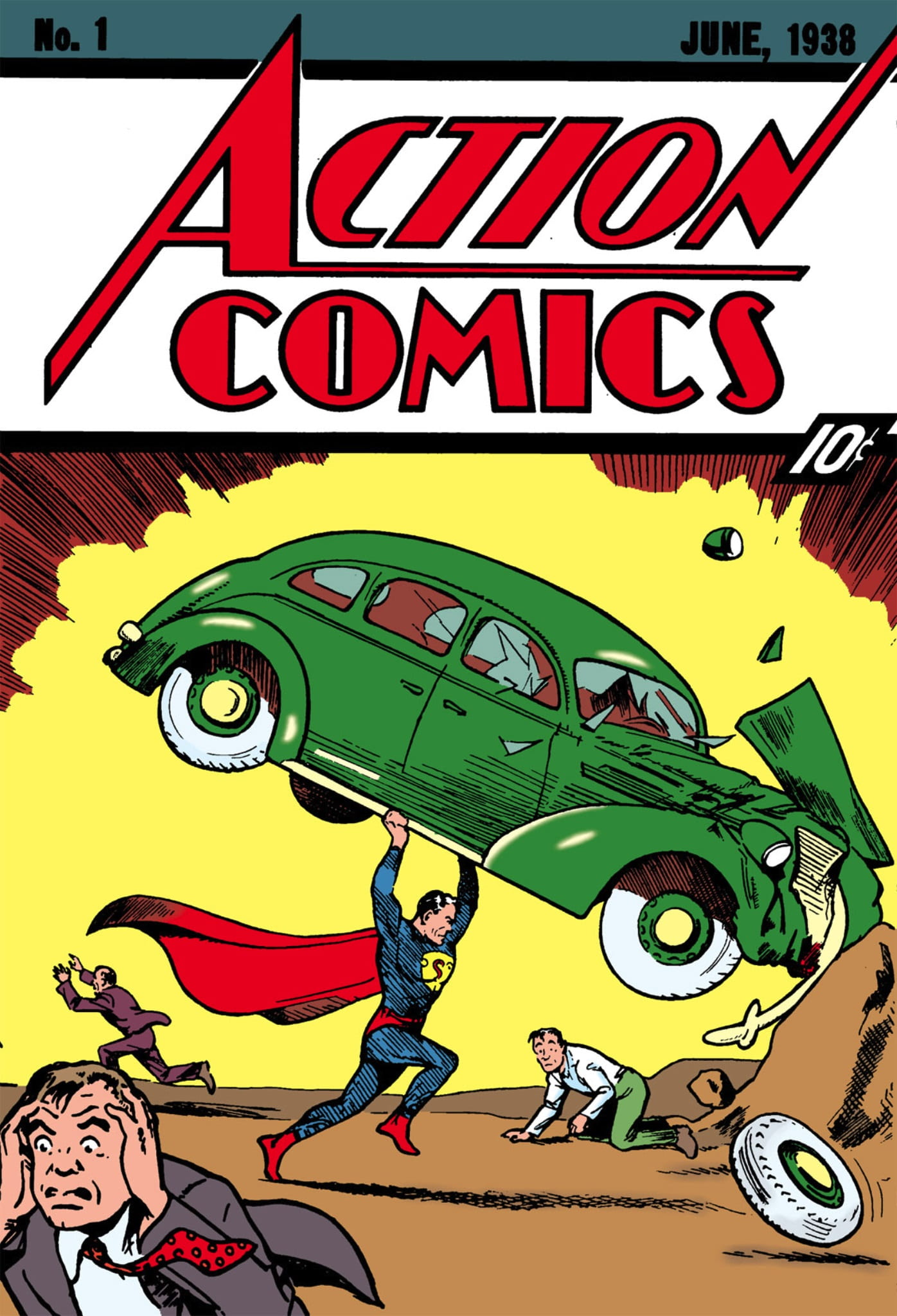
Comics are potentially incomparable resources given the cultural turn in the social sciences (a shift in the humanities and social sciences in the late 20th century toward a more robust study of culture and meaning and away from positivism). The sheer volume of narrative—somewhere in the realm of 10,000 sequential Harry Potter books– and social saturation—approximately 91-95% of people between the ages of six and eleven in 1944 read comics regularly according to a 1944 psychological study—remain singular today (Lawrence 2002, Parsons 1991).
Cultural sociology has shown us that “myth and narrative are elemental meaning-making structures that form the bases of social life” (Woodward, 671). In a lecture on Giacometti’s Standing Woman, Jeffrey Alexander pushes forward a way of seeing iconic experiences as central, salient components of social life. He argues:
Iconographic experience explains how we feel part of our social and physical surroundings, how we experience the reality of the ties that bind us to people we know and people we don’t know, and how we develop a sense of place, gender, sexuality, class, nationality, our vocation, indeed our very selves (Alexander, 2008, 7).
He further suggests these experiences informally establish social values (Alexander, 2008, 9). Relevant to our purposes, Alexander stresses Danto’s work on “disgusting” and “offensive” as aesthetic categories (Danto, 2003) and Simmel’s argument that “our sensations are tied to differences” with higher and lower values (Simmel, 1968).
This suggests that theoretically the comic book is a window into pre-existing, powerful, and often layered morals and values held by the American people that also in turn helped build cultural moral codes (Brod, 2012; Parsons, 1991).
The comic book superhero, as invented and defined by the appearance of Superman, is a highly culturally contextualized medium that expresses particular subgroups’ anxieties, hopes, and values and their relationship to broader American society.
But this isn’t a history of comics, accidental publications, or even the most famous hero of all time. As Ursula LeGuin says, “to light a candle is to cast a shadow.” It was likely inevitable that the superhero—brightest of all the lights—would necessarily cast a very long shadow. Who after all could pose a challenge to Superman? Or what could occupy the world’s greatest detective? The world needed supervillains. The emergence of the supervillain offers a unique slice of moral history and a potentially powerful way to investigate the implicit cultural codes that shape society.
I want to briefly trace the appearance of recurring villains in comic books and note what their characteristics suggest about latent concepts of evil in society at the time. Given our limited space, I’m here only considering the earliest runs of the two most iconic heroes in comics: Superman (Action Comics #1-36) and Batman (Detective Comics #27-; Batman #1-4).
 Initially, Superman’s enemies were almost exclusively one-off problems tied to socioeconomic situations. It wasn’t until June 1939 that readers met the first recurring comic book villain: the Ultrahumanite. Pursuing a lead on some run-of-the-mill racketeers, Superman comes across a bald man in a wheel chair: “The fiery eyes of the paralyzed cripple burn with terrible hatred and sinister intelligence.” His “crippled” status is mentioned regularly. The new villain wastes no time explaining that he is “the head of a vast ring of evil enterprises—men like Reynolds are but my henchmen” (Reynolds is a criminal racketeer introduced earlier in the issue), immediately signaling something new in comics. The man then formally introduces himself, not bothering with subtlety.
Initially, Superman’s enemies were almost exclusively one-off problems tied to socioeconomic situations. It wasn’t until June 1939 that readers met the first recurring comic book villain: the Ultrahumanite. Pursuing a lead on some run-of-the-mill racketeers, Superman comes across a bald man in a wheel chair: “The fiery eyes of the paralyzed cripple burn with terrible hatred and sinister intelligence.” His “crippled” status is mentioned regularly. The new villain wastes no time explaining that he is “the head of a vast ring of evil enterprises—men like Reynolds are but my henchmen” (Reynolds is a criminal racketeer introduced earlier in the issue), immediately signaling something new in comics. The man then formally introduces himself, not bothering with subtlety.
I am known as the ‘Ultra-humanite’. Why? Because a scientific experiment resulted in my possessing the most agile and learned brain on earth! Unfortunately for mankind, I prefer to use this great intellect for crime. My goal? Domination of the world!!
In issue 20, Superman discovers that, somehow, Ultra has become a woman. He explains to the Man of Steel: “Following my instructions, they kidnapped Dolores Winters yesterday and placed my mighty brain in her young vital body!” (Action Comics 20).
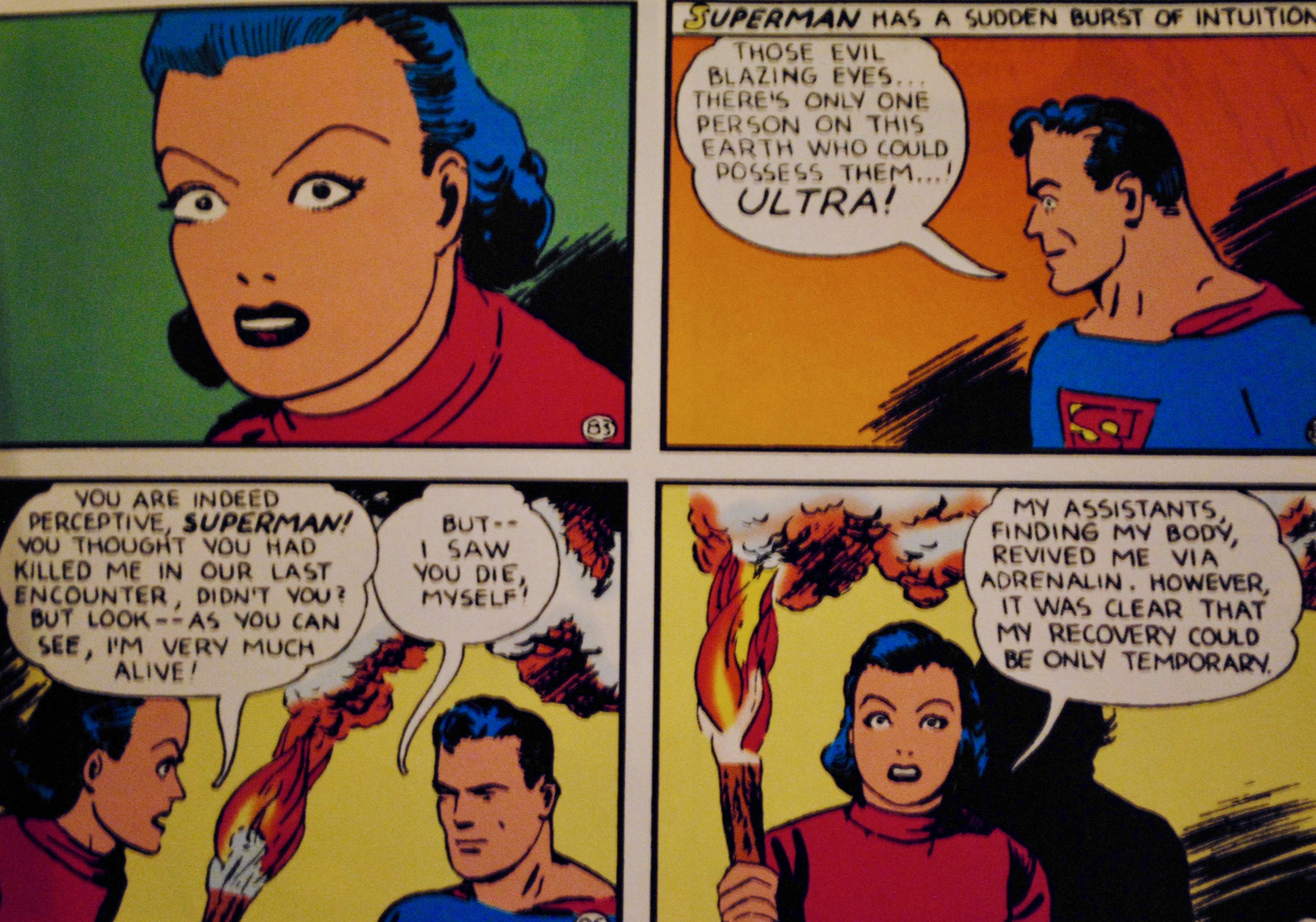
Superman found his first recurring foil in unfettered intellect divorced from physicality. It’s hard not to wonder if this reflected a general distrust of the ever-increasing destructive power of science as World War II dawned. It’s also fascinating to note how consistently the physical status of the Ultrahumanite is emphasized, suggesting a deep social desire for physical strength, confidence, and respect.
After Ultra’s death, our hero would not be without a domineering, brilliant opponent for long. Action Comics 23 saw the advent of Lex Luthor. First appearing as an “incredibly ugly vision” of a floating face and lights, Luthor’s identity unfolds as a mystery. Superman pursues a variety of avenues, finding only a plot to draw countries into war and thugs unwilling to talk for fear of death. Lois actually encounters Luthor first, describing him as a “horrible creature”. When Luthor does introduce himself, it nearly induces déjà vu: “Just an ordinary man—but with the brain of a super-genius! With scientific miracles at my fingertips, I’m preparing to make myself supreme master of th’ world!”
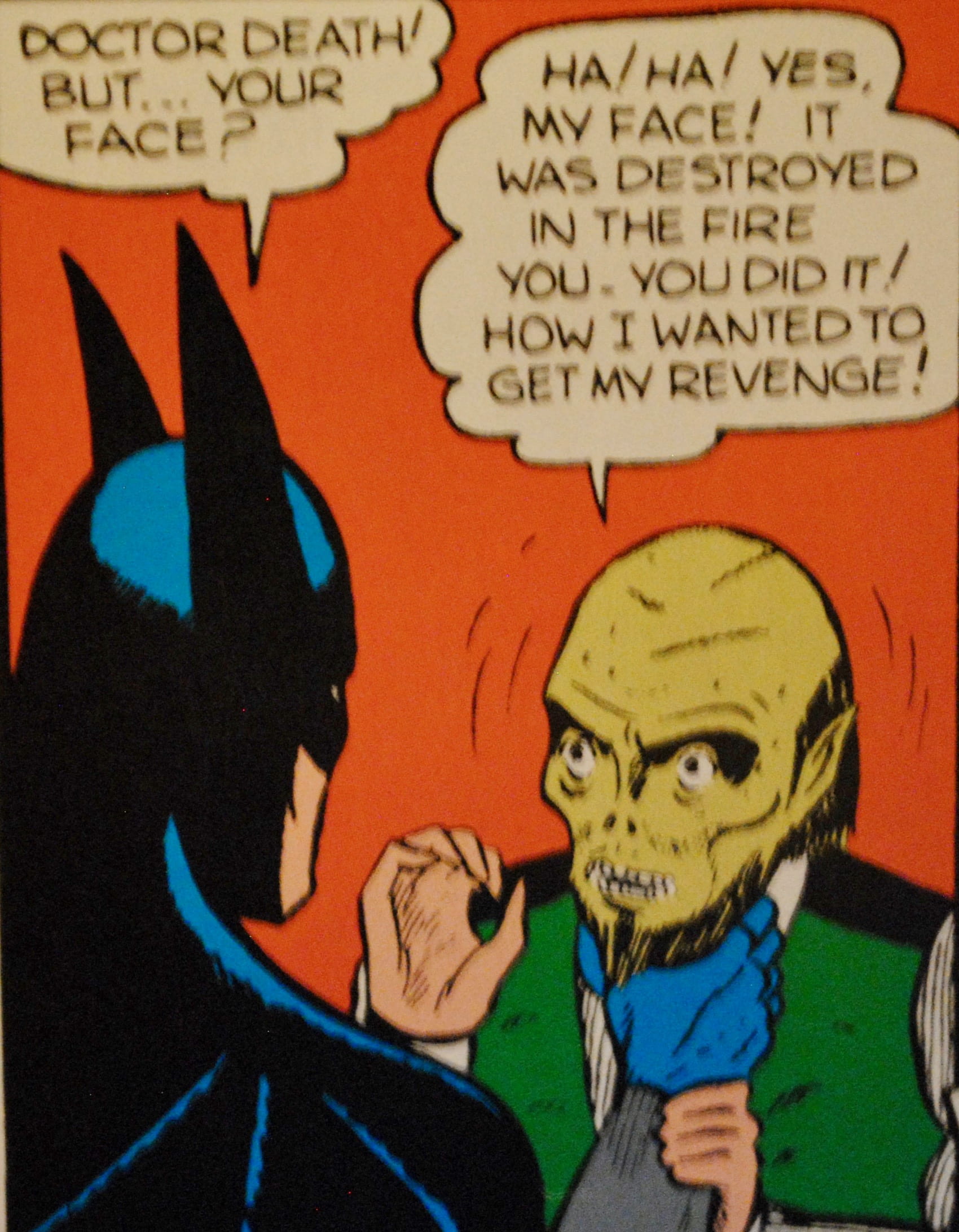 The Batman develops his first supervillain at nearly the same time as Superman. In July 1939, one month after the Ultrahumanite appeared, readers are introduced to Dr. Death. Dr. Death first appears in a lavish study speaking with a Cossack servant (subtly implying Dr. Death is anti-democratic) about the threat Batman poses to their operations. Death is much like what we would now consider a cliché of a villain—he wears a suit, has a curled mustache and goatee, a monocle, and smokes a long cigarette while he plots. His goal: “To extract my tribute from the wealthy of the world. They will either pay tribute to me or die.” Much like Superman’s villains, he uses science—chemical weapons in particular—to advance these sinister goals. In their second encounter, Batman prevails and Dr. Death appears to burn to death. Of course, in comics the dead rarely stay that way; Dr. Death reappears the very next issue, his face horribly scarred.
The Batman develops his first supervillain at nearly the same time as Superman. In July 1939, one month after the Ultrahumanite appeared, readers are introduced to Dr. Death. Dr. Death first appears in a lavish study speaking with a Cossack servant (subtly implying Dr. Death is anti-democratic) about the threat Batman poses to their operations. Death is much like what we would now consider a cliché of a villain—he wears a suit, has a curled mustache and goatee, a monocle, and smokes a long cigarette while he plots. His goal: “To extract my tribute from the wealthy of the world. They will either pay tribute to me or die.” Much like Superman’s villains, he uses science—chemical weapons in particular—to advance these sinister goals. In their second encounter, Batman prevails and Dr. Death appears to burn to death. Of course, in comics the dead rarely stay that way; Dr. Death reappears the very next issue, his face horribly scarred.
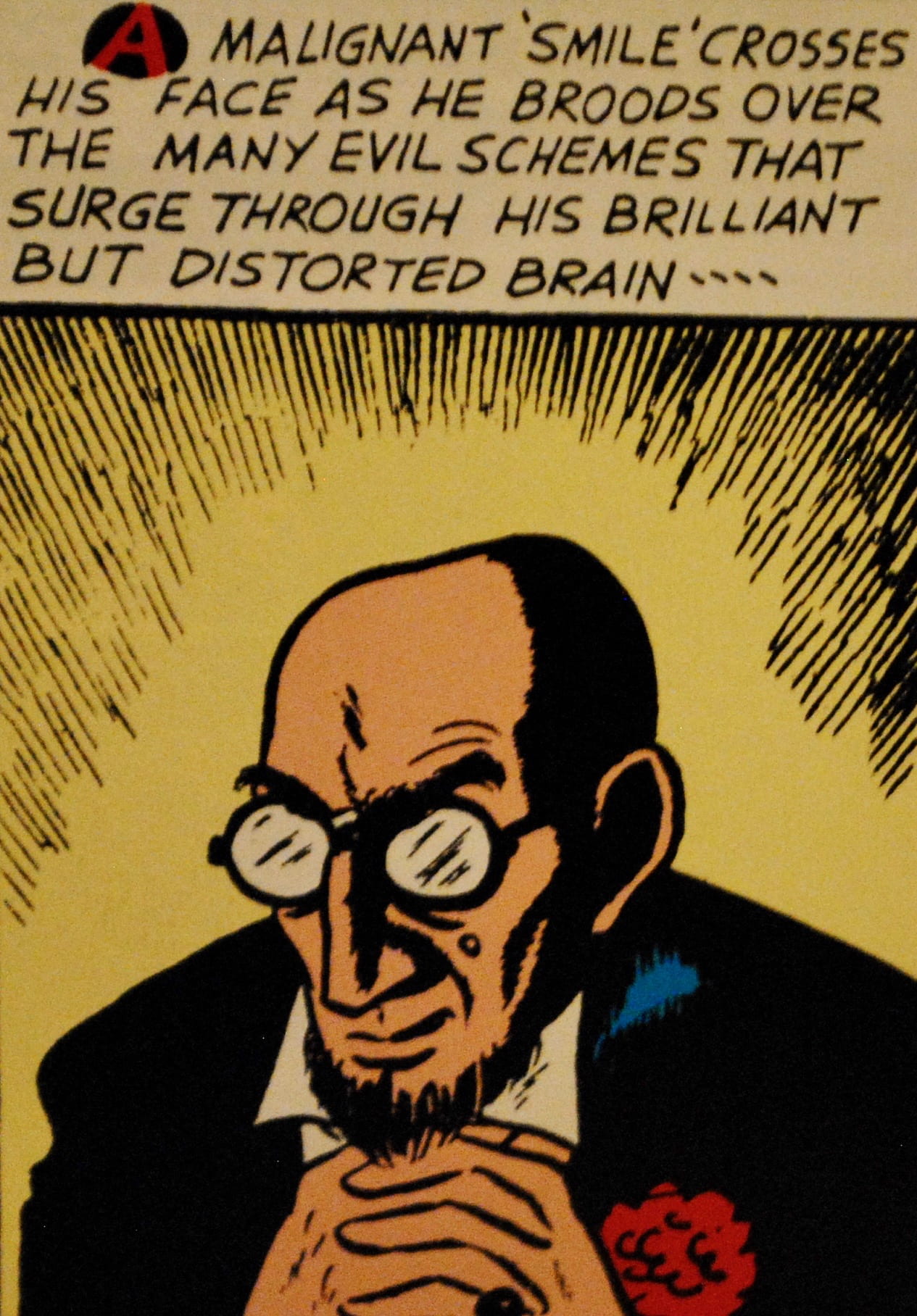 The next regularly recurring villain to confront Batman appears in February 1940. Batman himself introduces the character to the reader: “Professor Hugo Strange. The most dangerous man in the world! Scientist, philosopher, and a criminal genius… little is known of him, yet this man is undoubtedly the greatest organizer of crime in the world.” Elsewhere, Strange is described as having a “brilliant but distorted brain” and a “malignant smile”. While he naturally is eventually captured, Strange becomes one of Batman’s most enduring antagonists.
The next regularly recurring villain to confront Batman appears in February 1940. Batman himself introduces the character to the reader: “Professor Hugo Strange. The most dangerous man in the world! Scientist, philosopher, and a criminal genius… little is known of him, yet this man is undoubtedly the greatest organizer of crime in the world.” Elsewhere, Strange is described as having a “brilliant but distorted brain” and a “malignant smile”. While he naturally is eventually captured, Strange becomes one of Batman’s most enduring antagonists.
The very next month, in Batman #1, another iconic villain appears: none other than the Joker himself.
Once again a master criminal stalks the city streets—a criminal weaving a web of death about him… leaving stricken victims behind wearing a ghastly clown’s grin. The sign of death from the Joker!
Also utilizing chemicals for his plots, the Joker is portrayed as a brilliant, conniving plotter who leads the police and Batman on a wild hunt. Unique to the Joker among the villains discussed is his characterization as a “crazed killer” with no aims of world power. The Joker wants money and murder. He’s simply insane.
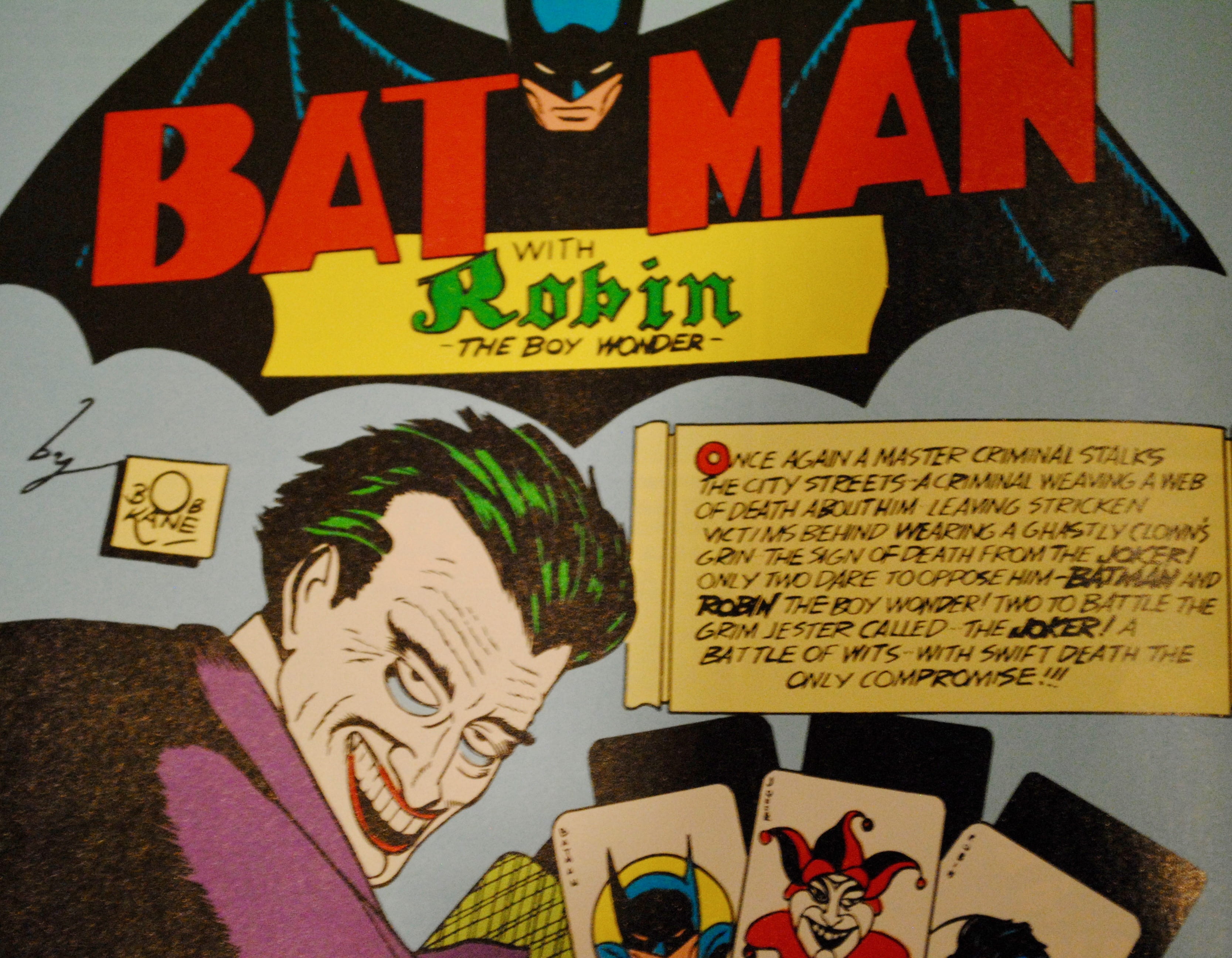
Some striking commonalities appear across our two early heroes’ comics. First, physical “flaws” are a critical feature. These deformities are regularly referenced, whether disability, scarring, or just a ghastly smile. Second, virtually all of these villains are genius-level intellects who use science to pursue selfish goals. And finally, among the villains, superpowers are at best a secondary feature, suggesting a close tie between physical health, desirability, and moral superiority. Danto’s aesthetic categories of “disgusting” and “offensive” certainly ring true here.
This is remarkably revealing and likely connected to deep cultural moral codes of the era. If Superman represents the “ideal type,” supervillains such as the Ultrahumanite, Lex Luthor, and the Joker are necessary and equally important iconic representations of those deep cultural moral codes. Such a brief overview cannot definitively draw out the moral world as revealed through comics and confirmed in history. Rather, my aims have been more modest: (1) to trace the history of the birth of the supervillain, (2) to draw a connective line between the strong cultural program, materiality, and comic books, and (3) to suggest the utility of comics for understanding the deep moral codes that shape a society. Cultural sociology allows us to see comics in a new light: as an iconic representation of culture that both reveals preexisting moral codes and in turn contributes to the ongoing development of said moral codes that impact social life. Social perspectives on evil are an actively negotiated social construct and comics represent a hyper-stylized, exceedingly influential, and unfortunately neglected force in this negotiation.
Albert Hawks, Jr. is a doctoral student in sociology at the University of Michigan, Ann Arbor, where he is a fellow with the Weiser Center for Emerging Democracies. He holds an M.Div. and S.T.M. from Yale University. His research concerns comparative Islamic social movements in Southeast and East Asia in countries where Islam is a minority religion, as well as in the American civil sphere.



1 Pingback